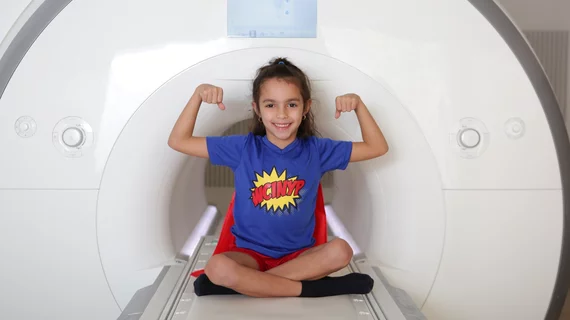It can be difficult to convince a child to sit still through an MRI scan, especially without an assist from anesthesiology. One academic medical center is changing that norm with the help of Captain America and Iron Man.
Weill Cornell Imaging at New York-Presbyterian has since 2014 been using simple, inexpensive educational tools, including a comic book and pre-imaging video, to drop sedation rates. The “MRI-am-a-Hero” program is already showing promise, decreasing by 40% the odds that providers would perform a study with sedation.
“This program has the potential to decrease the adverse side effects of sedation in children,” experts with Weill Cornell Imaging wrote in a study published Sept. 27 in the Journal of the American College of Radiology. In addition, they believe the approach can also “reduce patient and parental anxiety, decrease cost on the radiology practice, improve imaging patient flow and decrease cost on the healthcare system.”
The reasons to avoid sedation in child patients are well documented. Kids can struggle with fasting the night before an MRI; pediatric patients are at a higher risk of hypoxia during the procedure, and motor imbalance, agitation and restlessness afterward; parents can often leave the visit dissatisfied; and using sedation or anesthesia during an MRI boosts procedure expenses.
One University of Toronto study found that patients subject to anesthesia or sedation spent upward of almost two hours longer in the hospital, with costs nearly 10 times higher in the worst cases.
With all of that in mind, Weill Cornell designed MRI-am-a-Hero to improve patient care and avoid such concerns. A child life specialist leads the program, targeting patients aged 4 to 15. Before the procedure, patients receive a customized comic telling the story of Captain America injuring his shoulder on the job. At the urging of Iron Man and with the help of a little girl, Cap goes to get it examined. Patients also watch both a 6-minute visit about the little girl’s MRI journey and a demonstration of the examination using a tabletop model.
Children enter the MRI wearing a superhero T-shirt and shorts, rather than a hospital gown, and holding a plush toy of Captain American or Iron Man; video goggles are also worn during some procedures that do not require holding one’s breath. Afterward, kids also receive a cape as their “badge of honor,” and the child-life specialist is present throughout the visit to help relieve any parent or patient anxiety.
Weill Cornell Imaging has been impressed by the results thus far, with the number of MRI cases using sedation decreasing by 5.6 percentage points, down to 17.3%. Controlling for other variables—including age, neurological MRI, number of exams in a case and the use of intravenous contrast—the odds of a radiologist performing the procedure without sedation dropped by 40%.
The authors believe other radiology practices can replicate the results. MRI-am-a-Hero was relatively inexpensive, with the materials costing less than $27, and full-time child-life specialists earning an average salary of about $43,000.
Children’s sense of pride and achievement afterward is palpable, Rachel Cavaliere, study co-author and a radiology child-life specialist at Weill Cornell Imaging, said in a statement.
“This environment and this program allow kids to complete their exams in a fun and non-threatening way,” she said. “When you’re prepared ahead of time and know what to expect, you’re going to be less scared and more compliant.”
Related Content on Fasting Prior to Imaging Exams:
Radiology: No need to go hungry prior to CT as fasting largely unnecessary
Fasting before contrast-enhanced CT exams is unnecessary, experts say
Providers are not communicating important FDG PET/CT recommendations to patients

